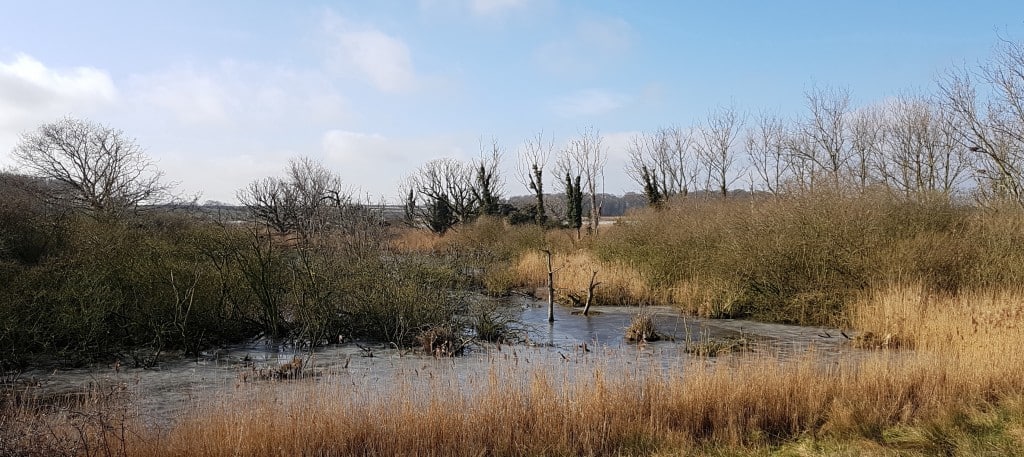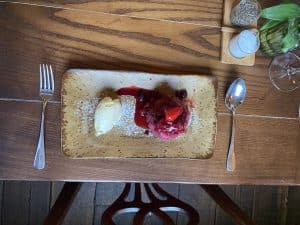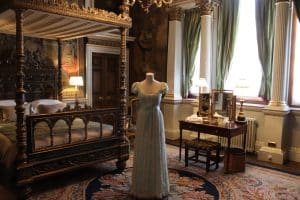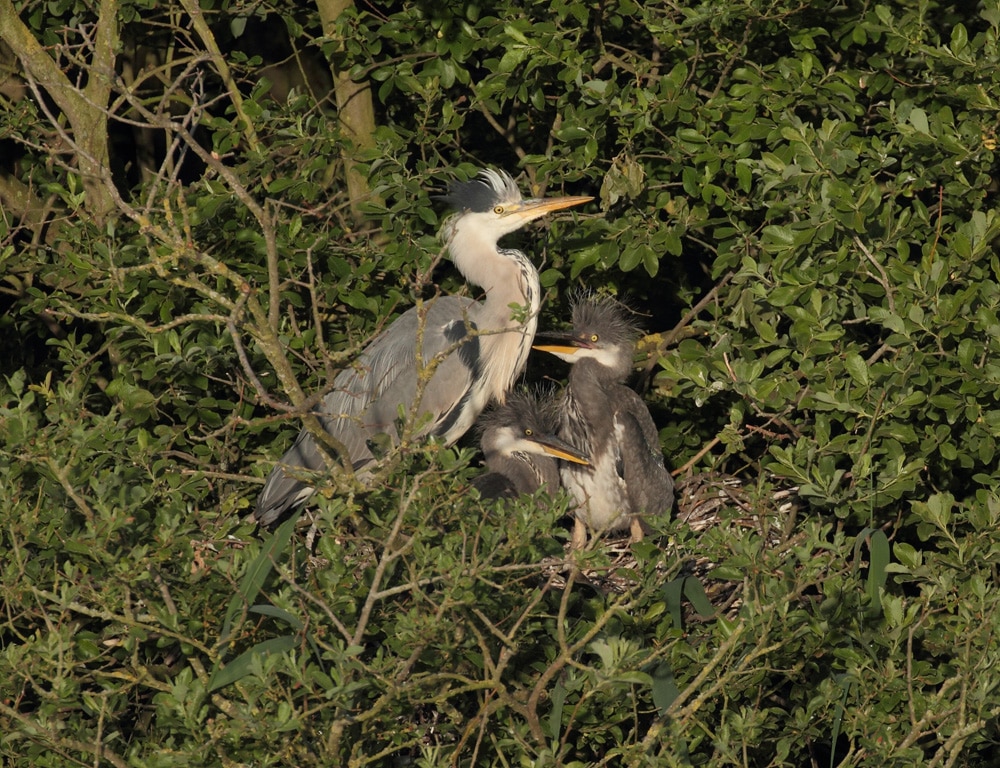
The Grey Heron – Holkham’s Longest Surveyed Bird
April 19, 2018 | Learning | 8 minute read
Decoy Wood at Holkham NNR – the site of our nesting Grey Herons
A great deal of the work we do on the reserve in the spring and early summer months is centred around monitoring birds. This involves regular visits to the grazing marshes (mainly) to assess population sizes and productivity of selected species alongside searching for evidence of legally controlled predators such as foxes and crows and patrolling at peak season to ensure the reserve is safe from egg collectors or any other detrimental pursuits that might have implications on the breeding wildlife. In doing this there are many benefits; by knowing the populations of certain species and their distribution it enables us to judge future habitat management decisions and see how good a condition the reserve is currently in. Another theory widely quoted is that if the reserve is good for birds then it should also be good for a whole host of invertebrates below them in the food chain; in other words the perfect ecosystem.
One of the surveys we are undertaking this year has great significance not only at a local level but nationally too. This year marks the 90th anniversary of the BTO Heronries Census. It is the longest running continuous survey of any bird species not only in the UK but in the world. Here at Holkham our records for Grey Heron go back even further, 1870 to be precise. Whilst our set of information has gaps we can glean enough to track their progress and movements over nearly 150 years.
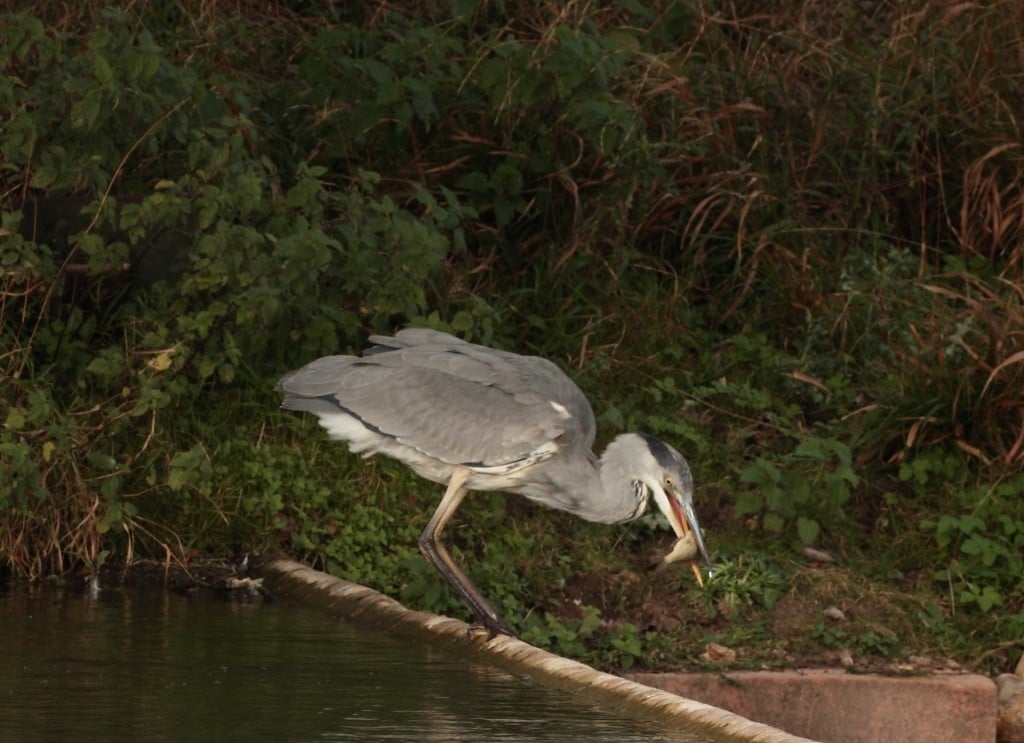
Grey herons are renowned for eating fish but their diet is actually far more varied
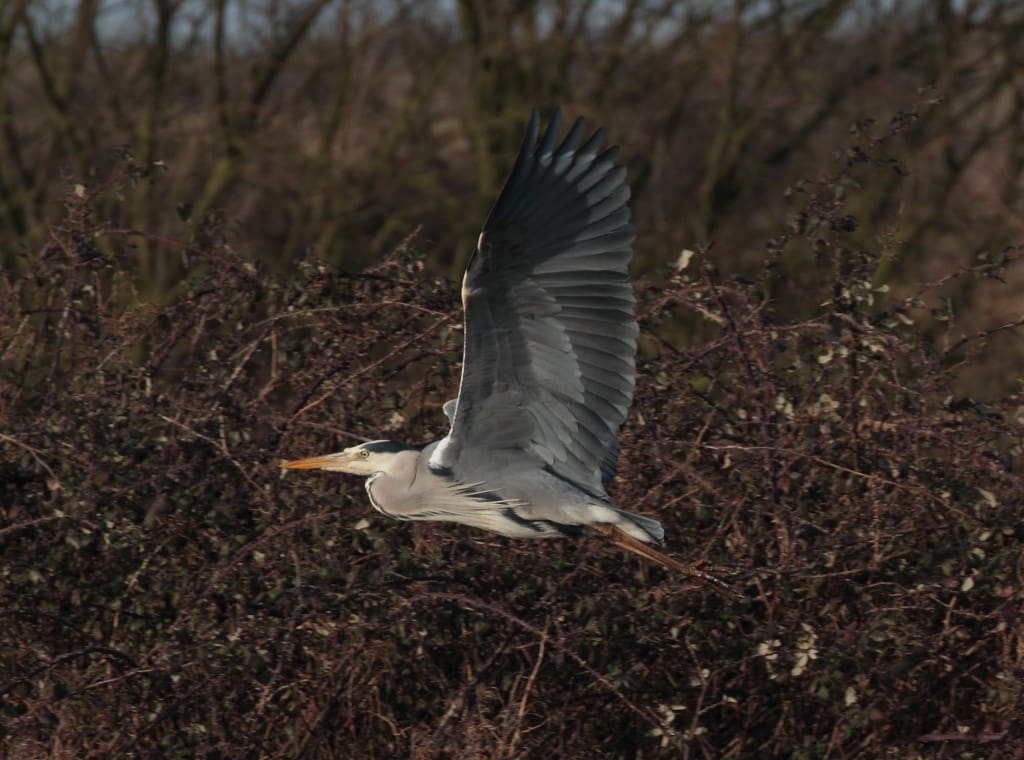
With a wing span of close on two metres the Grey Heron is a large bird in flight
Grey Herons are probably instantly recognisable to anyone with an interest in wildlife, being a familiar sight on rivers, lakes, and even garden ponds. Renowned as being the ultimate ‘fisherman’ there is actually a lot more to the heron’s lifestyle than is widely known. Herons eat far more than just fish; they are classic opportunists. Small birds, amphibians, and small mammals are just as keenly sort after. One prey species not so widely associated with herons is the mole.
A lot of heron sightings at Holkham particularly in the winter months are of birds wandering about or standing still in the middle of some of our drier fields. Watch for long enough and you might be fortunate enough to see one strike down into a mole hill and emerge with a victim. There can’t be too many species that prey so habitually upon moles as herons do. We recently found a discarded pellet from a heron (they are like owls in the fact that undigested fur and bones are ejected as pellets) and it was all mole fur and claws and at four inches long it was far bigger than any owl pellet we have found.
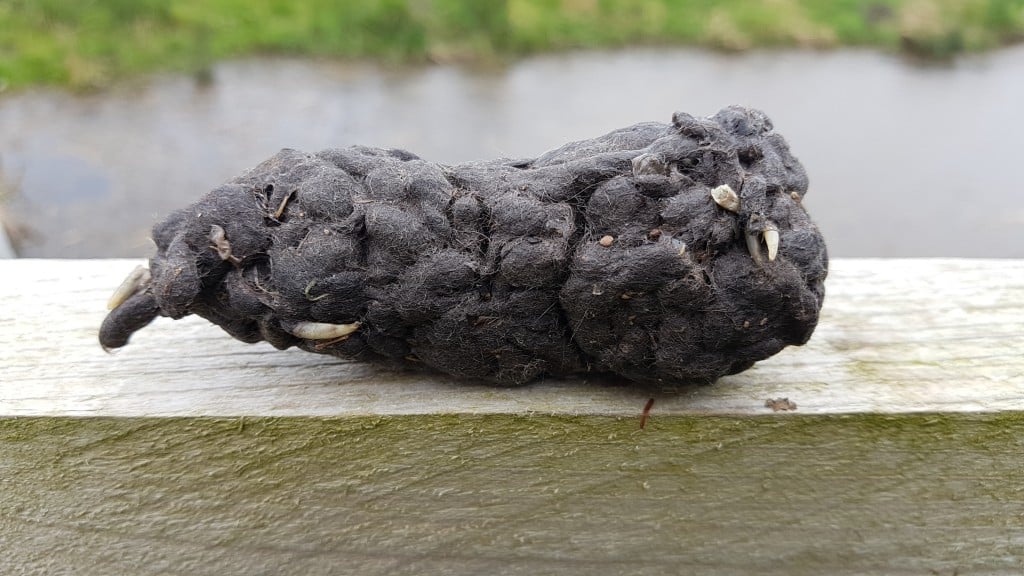
The discarded pellet of a Grey Heron complete with fur and claws of a Mole
So whilst Grey Herons prefer wetland habitats to feed in they also need adjacent woodland in which to nest. This is where the survey work comes in. Herons are generally creatures of habit, nesting in often long established colonies (heronries) and it is the number of nesting pairs that are counted all around the country. With our UK herons being predominantly resident birds the long running national survey has picked up trends that would have otherwise been missed. Long spells of cold winter weather can be disastrous for many birds, especially herons. With frozen waterways or low numbers of other prey species, feeding can become very difficult and herons will soon perish. When the UK survey begun in 1928 it was judged that the population was just below 10,000 pairs and since then the overall trend seems to have been one of shallow increases and periodic lows to an estimated peak of 14,200 in 2003. Dips have been noted following harsh winters but it is thought that greater protection, a wider abundance of wetland habitat and predominantly milder winters have been the reasons for the greater numbers in recent times.
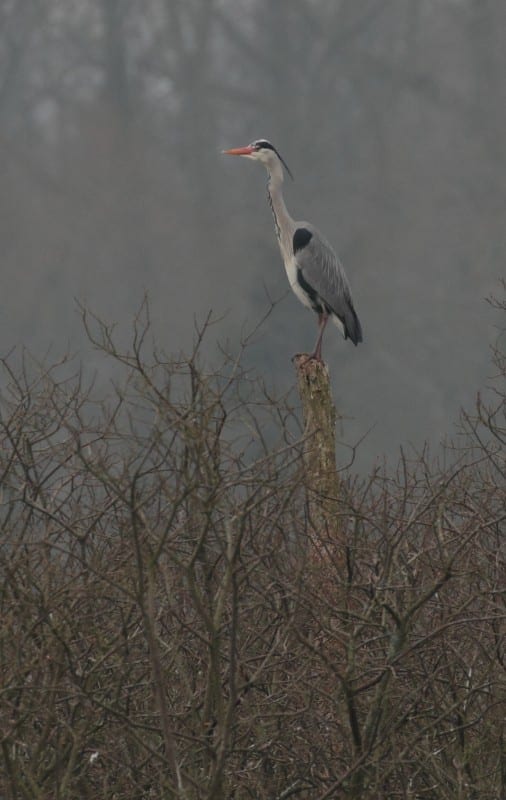
This male Grey Heron was perched on the tree tops looking out for a mate
At Holkham the Grey Heron is really one of our oldest and most faithful inhabitants of the area. They started out nesting near Holkham Church in 1870 and by 1879 33 nests were counted. This is probably the earliest accurate count of a breeding population of wild birds at Holkham. By 1900 a second heronry had begun in the Park at Obelisk Wood, although in 1910 a large clearing up operation at the Lake caused too much disturbance and the Church Wood site was deserted never to be used again. In the meantime the Obelisk Wood site continued to thrive peaking at 30 nests in 1928. Numbers fluctuated here until they finally deserted that site in 1999. The reason this time seemed to be the then recent improvements done on the NNR’s grazing marshes. With more standing water and deeper more maintained dykes the area soon became a magnet for feeding herons and it was also far less disturbed than Holkham Lake. It was no surprise that herons started to nest in Decoy Wood in 1993, our small wetland wood in the centre of Holkham marsh. Here they have continued to nest annually where numbers have so far peaked at 12 nests.
When I was growing up in Holkham Park in the 1970s, one of my earliest ‘bird’ memories was being taken into the Obelisk Wood by one of the old gamekeepers to see the ‘ol harnsers’ as they were commonly known as by older people from Norfolk. Here they nested on top of some of the oldest Holm Oak trees in the Park. That old keeper also told me that there were not any other birds that were ‘in the nest’ for so long. With a nesting season that can begin in late February and with the last fledglings taking to the wing in August he was not far wrong. Holm Oak trees have dense evergreen foliage making viewing far from easy. Yet I can still recall squinting through the boughs and leaves to see yellow beaks and flashes of grey plumage glinting through the gaps. What left the most impression were the noises. Herons seem to have a large repertoire of vocalisations, none of them particularly pleasant! The most regularly heard noise is a deep ‘raarrk’ when the adults fly, but at a nesting colony all manner of unearthly groans, screams and yelps can be heard. For someone visiting for the first time it really does sound like a demonic spine tingling cacophony!
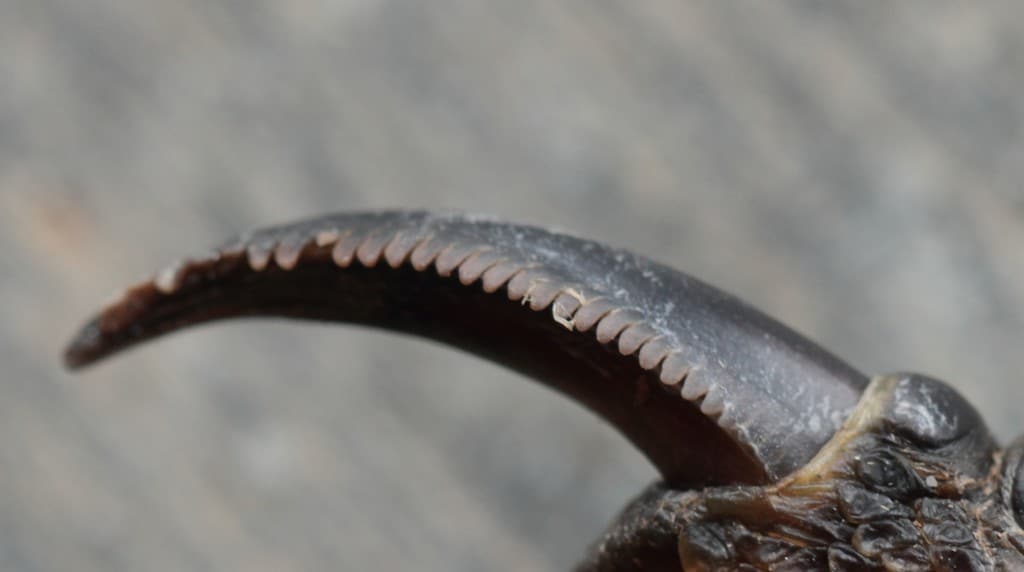
The comb-like ‘pectinate’ claw of the Grey Heron’s middle toe
When the cold weather this March set in, what looked like an early start to the nesting season came to an abrupt end as the prospecting birds temporarily deserted their colony. Not surprisingly we also found a dead bird, pitifully thin. This gave us a chance for a close up examination of a species only usually seen through optical aids. One of the features of a heron I particularly wanted to see was the middle claws on each foot. Certain birds such as herons, bitterns, cormorants, and even some owls and nightjars have peculiar comb-like grooves alongside the edge of the middle claw. This is called the ‘pectinate’ claw. Herons and bitterns also have ‘powder downs’ on their body. This is a special gland under the skin which when rubbed produces a fine powder that is liberally spread over their plumage with this special claw when the feathers are wet and slimy and helps them to dry and could be described as a marvellous trait of evolution. As I currently write, as many as six birds are already on nests incubating their eggs with the first youngsters just hatched but with it being a late cold spring our hope is that more will arrive. In the meantime if you see a heron, take time to watch it, you might now see it in a very different way.
Andy Bloomfield, Warden Holkham NNR
View all latest blog posts here.
